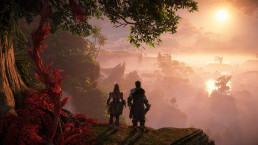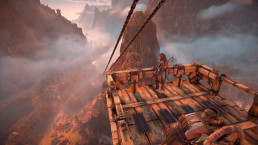Even in places in the game world where hardly anyone goes, Aloy is recognized in Horizon Forbidden West. The first thing she hears? “If it isn't the Savior of Meridian!” Well, Aloy saved the world in Horizon Zero Dawn and the world has not gone unnoticed. Yet it is almost as if everyone has collectively forgotten that the world's greatest hero is simply called Aloy.
In any case, the Amsterdam Guerrilla Games is not. The studio celebrates its best character in Forbidden West as sequels rarely do. Aloy is the heart and soul of this game. It’s heartwarming to meet her old friends, remember adventures from the first part, and see how everyone in the world has heard about Aloy’s exploits. No one doubts her ability.
Aloy herself thinks otherwise. Uncomfortably and hesitantly, she waves the compliments away in Forbidden West. Savior of Meridian? “Just call me Aloy.” She says it over and over. That aversion has little to do with a latent impostor syndrome. Aloy doesn’t feel like a heroine because she knows what’s to come. In Zero Dawn she learned who she really is and what her role is in the game world. The real work has yet to begin.
The beginning of Forbidden West elaborates on the events of the previous part. After that, the game starts to juggle more and more jargon. That’s one of Horizon’s strengths – the world derives its depth from it. At the same time, that makes the story inaccessible. If you’ve never played Zero Dawn or have forgotten much of the story, I recommend checking out this refresher on YouTube.
Zero Dawn’s story was good, but it only really spurred on after a big reveal halfway through the game. Forbidden West goes wild earlier, but still takes a hefty run-up. The game starts in a defined area, similar to Assassin’s Creed: Valhalla. The first few hours are a bit of a pull, but once in the West, the game gets going right away.
A certain tribe then throws the bat in the henhouse and it is probably up to Aloy to knit everything to a good end. Unsurprisingly, Forbidden West is about much more than clans and their plotlines, which are once again bursting with political twists and animosity. Still, I did not expect that there was still so much to tell about this game world.
Guerrilla Games has been far from open-handed in Horizon Zero Dawn. Forbidden West has plenty of surprises in store.
Partly because of all those twists, this game has a wonderful flow. You really fly through the story. The loaded main missions continue to deepen the world in new ways, while stories within side missions are often worthwhile too. Some side missions even pick up on the overarching storyline and introduce characters who will play a role later on.
The motion capturing of those characters is also sublime. People gesture happily and have recognizable manners. The facial animations are also very well done. The contrast with some plastic left off Zero Dawn is truly colossal. Certain characters have gotten a little more attention than the minor roles, but overall the animation and voice work is top notch.
The actors have had enough source material, because Forbidden West is bursting with dialogue. Sometimes you are listening for minutes. Despite the aforementioned excess of jargon, the writing is sharp and at times even surprisingly funny. You will not be laughing in your living room, but the humor is well dosed and different ’types’ within the cast are used well.



The story deserves all the praise and, together with the game world, is continuously intriguing. Playing a hunter-gatherer in a post-post-apocalyptic world makes the Horizon series completely unique. That is also ironic in a way, because the open world activities themselves are slightly less unique. Forbidden West is sort of a compilation album of everything you know from open world games.
You have the towers from Assassin’s Creed, the outposts from Far Cry, the question marks from The Witcher, the glider from Zelda: you know it by now. The structure of the game world is the same as in Zero Dawn. It’s not like Forbidden West is suddenly mimicking the freedom of Breath of the Wild. No, you are still going through question marks on the map or scrolling through missions in a menu. “You know” is not an overstatement in that sense.
That is by no means a criticism, let that be clear. While Zero Dawn could have been a linear game according to some critics, Forbidden West benefits a lot from the variety of an open world. That’s because there are more diverse activities that are actually fun to do. The side missions in particular have improved enormously. They introduce entertaining scenarios and some unique environments.
For example, mild platform puzzles regularly play a role during side missions. Aloy can now climb mountain walls, a bit like Breath of the Wild, but only in the case of certain rocks. Sequences like this are really, really fun. The Cauldron Caves are certainly platform highlights. Those almost Ratchet & Clank-esque levels are bursting with spectacular running and flying action.
A little less impressive about the platforming is the erratic controls. Aloy sometimes forgets to extend a reaching hand prior to a jump. Several times I swore back to the beginning of a platform section. It turns out that you have to wait until Aloy extends that hand. That takes some getting used to.
Speaking of which: I also had to get used to the mounts in this game. On the one hand they go fast and that is great, but too often you are braked because you get stuck behind a rock or a protruding branch. In addition, it is difficult to estimate which rivers you can or cannot cross, depending on how deep they are.
This is inconvenient, but also manageable over time. You get used to it. You have to, because the game world is so vast that sometimes you can’t do without your mount, especially if you can’t fasttravel for a while. The Forbidden West is huge. You travel a lot of lonely miles to get everywhere.



This game world is bursting with different types of environments and one by one they are indescribably beautiful. The distant vistas and exposure form a sort of scenic tandem. I fell silent for a moment as the morning sun rose over the mountains for the first time to paint the landscape red.
What steals the show in particular is the art design. In the environment where the game starts, that’s not too bad, because everything takes place in a small canyon. But gosh, once you get to the West, the sequel unfolds in ways I can barely explain. How this game blends old (modern technology) and new (a world full of indigenous tribes) is spectacular from start to finish.
One minute you’ll be amazed at the tribes and their authentic cities; fifteen minutes later, you’re gazing at a half-collapsed space center, fighter jets overgrown by moss and colossal carcasses of machines that blend into the mountain landscape. So consistent, so unique, so much detail: this is an absolute masterclass in art design, also underwater.
The pop-in is minimal and the frame rate constant, at least on the PlayStation 5. It is recommended to play the game at the highest frame rate (60). The resolution is then lower, but you don’t notice that much, probably partly due to post-processing. Of course you can play the game with all the bells and whistles at the highest resolution, but then you have to take into account a frame rate that does not exceed 30.
And that’s inconvenient, because the recognizable and satisfying action can certainly be very hectic against big opponents. In addition, Aloy’s knee slide deserves an honorable mention. Aloy can slide on her knees on the ground for many meters – even longer when going downhill. While she is sliding, you can adjust her very accurately, for example around corners. It’s a small mechanic, but oh my gosh, it feels good.
Horizon Forbidden West introduces more such adjustments that feel good right away, but don’t seem significant in themselves. Take the fine checkpoints, more extensive skill trees, nicer upgrades for your weapons or the smooth fasttravel. The critic will then say: With such adjustments, Forbidden West does not change the rules of the open world genre.
Correct. In fact, Forbidden West doesn’t do that anyway, not even compared to other Sony games.
Ghost of Tsushima includes more subtle tricks to guide you through the game world, such as the wind showing the way and animals showing you where to go. Forbidden West is a more traditional open world game, one that relies on quest markers and menus with commands like its predecessor. You are not guided through the world ‘automatically’. Exploring mainly means going into question marks on the map.
It doesn’t matter at all. It’s obvious that Guerrilla Games wants to bet with Forbidden West on everything that makes Horizon Zero Dawn fun and unique. The result is a very trimmed sequel where you rarely do anything you don’t feel like doing. Forbidden West is captivating to follow, fun to play and beautiful to watch across the board. And to think that this gaming year has practically yet to begin.
Horizon Forbidden West is available on February 18 on PlayStation 4 and PlayStation 5. We played the game on a PlayStation 5.
Conclusion: Better, smoother, better written, phenomenal art design, a consistent story, more surprises and better main and side missions: Horizon Forbidden West is better than its already sublime predecessor Horizon Zero Dawn on almost every front. Big kudos to Guerilla games, homegrown pride!
Score:
9,5
+ Beautiful game world with sublime art design
+ Entertaining and varied missions
+ Story full of revelations and surprises
– Minor cosmetic flaws
– Platforms don’t always run smoothly.